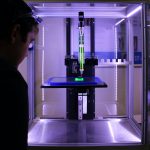3D Printed Precise Magnets Using Special Stainless Steel
In what may appear to be no big deal -- but is in fact, a big deal -- 3D printed magnets have been created by using laser beams and metal powder. Empa team, led by Aryan Arabi-Hashemi and Christian Leinenbach, used a special type of stainless steel to precisely 3D print magnets, with a final result looking like a metal chess board. The board is four millimeters long on each side with alternating darker and lighter spots in the shape of squares. Eight of these squares are magnetic and the other eight have non-magnetic properties.
How It Was Made
The entire piece was 3D-printed from a single grade of metal powder. Not only can it create new geometric shapes, but it can also produce new materials with new functionalities. The only variation during the creation was power and duration of the laser beam.
The stainless steel was developed about 20 years ago by the company Hempel Special Metals. This one uses P2000 steel which does not contain nickel. Instead, it contains about 1% of nitrogen. Since steel doesn’t cause allergies –– usually related to nickel –– it can be better suited for medical applications where magnets are typically needed. The drawback has been that under the melting point of the laser beam, this material’s temperature quickly peaks, evaporating the nitrogen in it.
The team didn’t let this drawback deter them though. In their research, Empa determined the nitrogen content in tiny, millimeter-sized metal samples and then measured the local magnetization to within a few micrometers. They realized that by modifying the scanning speed of the laser and the intensity of the laser beam, they could vary the size and lifetime of the liquid melt pool made up of particles in the metal powder bed. They found that a larger melt pool allowed more nitrogen to evaporate from the alloy and the solidifying steel crystallizes with a high proportion of magnetizable ferrite. With the smallest melt pool, the melted steel solidifies much faster, with the nitrogen in the alloy remaining. The steel here crystallized mainly in the form of non-magnetic austenite.
What This Means
This info found can also be used to further study the methodology of metal production and processing as this method isn’t limited to stainless steels, but can also be used for many other alloys.
"This allows us to vaporize various components of an alloy in a targeted manner—e.g. manganese, aluminum, zinc, carbon and many more—and thus locally change the chemical composition of the alloy." –– Leinenbach. In addition to medical applications, the ability to produce different alloy compositions with micrometer precision can also be helpful in the design of more efficient electric motors.
Discover More With Apex Magnets
For the first time, it’s now possible to build the stator and the rotor from magnetically fine structured materials. Simply put, the parts of the electric motor can better use the geometry of magnetic fields. For more of the the latest magnetic news, check out our magnet facts section of our blog.

